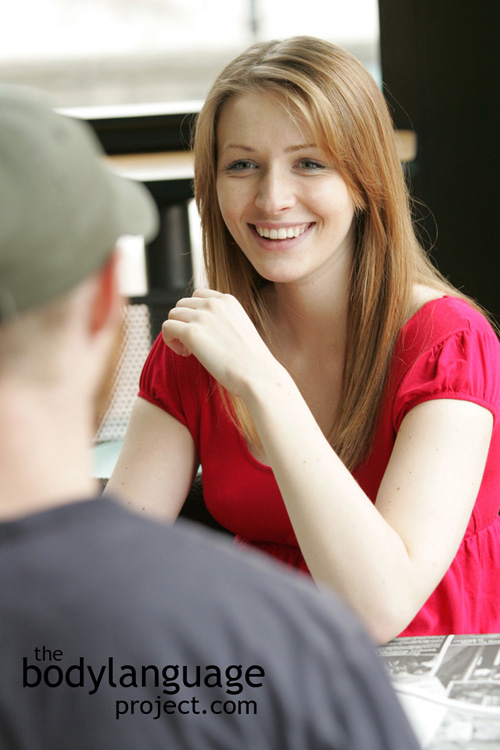An extreme form of closed posture is the fetal position. While it might seem far fetched to expect someone in your company to have this posture, it does occur although in more abbreviated adult acceptable ways. While at an informal party, for example, a women in might find herself hugging her knees at the end of a couch. To her, this feels comfortable, which is why she does it, but it reveals her true emotions. When in a public she is timid and reserved so she curls up in a ball. The abbreviated form of this position, of course, and one that is more acceptable in public is to pull the limbs in closer to the body and across the center-line as in the “self hug”. With age, we learn that taking up the fetal position, like thumb sucking, is not an acceptable way of dealing with our insecurity so we drop the extreme form of the gesture in favour of more subtle cues. Playing with the hair, rolling it around a finger, sucking on it, or a pen, or other oral fixations are also juvenile coping behaviours that become unacceptable, although often still continue, into adulthood.
Tag Archive for Adulthood
Who Smiles More, Men Or Women, And Why?
by Chris Site Author • March 5, 2013 • 0 Comments
The research on smiling shows us that women tend to smile the most and that they also tend to smile regardless of their emotional state. Men will and can get away without smiling the most as men who don’t smile are seen as dominant whereas women who don’t smile are seen as unhappy or angry. We might feel that this is simply a learned or cultural phenomenon but the fact is that smiling differentials between men and women happen very early in life. Little girls by the age of eight begin to smile much more whereas little boy lag further behind and they continue to lag behind into adulthood.
Women are obliged to smile to appease men according to researcher Dr. Nancy Henley at UCLA. She felt that women smiled simply to placate men and that since men normally occupy the dominant roles, women felt pressure to submit to their dominance. She felt smiling differences had nothing at all to do with women as nurturers and pacifiers. This might not be the whole story though. The research also shows us that while women that smile more are taken less authoritatively, women, regardless of their social status and position tend smile more than men. This is the case even when they hold similar job positions showing us that they smile more often even when they don’t have to Other research though confuses these findings and says that sometimes women of equal status to men, tend to use smiles similarly.
However, this certainly wasn’t the case for my wife, who, I had run a ‘smile boycott’ in light of the research done on smiles by Marianne La France. A ‘smile boycott’ is fairly simple, I explained to my wife, all she had to do was smile when she was happy and not smile when she wasn’t. You might try the same experiment for comparison. At first, she found it difficult to bring to consciousness the instances when she smiled because it happens subconsciously, but once she got the hang of it, she found that she smiled a lot.
In fact, at work, she smiled almost continuously, and so it was difficult at first for her to avoid smiling. She found that as she passed male colleagues in the hallways, she’d feel inclined to smile, even though they often failed to reciprocate. Men, she found, would merely nod their heads as they passed. When conversing with other female coworkers, they too tended to smile but if they didn’t, she reported back that she felt as if they were ‘rude.’ If she held a ‘non-smiling’ face for any prolonged period of time, she was questioned; “Are you okay?”, “Lighten up” or, “What’s bothering you?” She simply couldn’t get away with smile avoidance; the world wouldn’t let her. While this is far from scientific, it does illustrate well the trend we find in the scientific research. Women that don’t smile are reported negatively whereas women who smile more, tend to be viewed much more positively.
Further research shows us that smiling is in fact an option for the powerful regardless of their sex. Whereas less powerful people are required to smile more to appease those in higher positions, those higher up, need not placate those below. Interestingly too, is that women usually feel the need to please others, whereas men don’t, and they tend to correlate this need to please with smiling. Therefore this need to please might be at the root of all smiling. Armed with all this information, you can use the smile for your purpose, be it to placate, appease or neither.
Eye Size And Neoteny
by Chris Site Author • March 5, 2013 • 0 Comments

Science shows that women who have neotenous characteristics like big eyes tend to illicit protective feelings in others.
All children are born with a small nose, round chubby cheeks, soft skin, big eyes that are set low on their faces, and a big round face. We call these features “neotenous” as they remind us of characteristics found near birth. As early as the 1940’s it was found by researchers that these features make infants appear cute and lovable and increase the likelihood of eliciting care behaviour from parents. Even cartoon characters directed at children take up similar morphology. If you’ve ever compared Mickey the famous mouse to a real life mouse, you will note the difference in ratios their eyes hold. Real mice have very tiny eyes when compared to a creature that is much more beloved.
Studies show that women who have big round eyes are seen as more attractive a trait that goes across cultures and ethnicities. Thus, the preference for the neotenic condition also persists throughout adulthood. The studies also found that a “halo effect” surrounds women with big eyes and that we naturally feel that they are warm, caring, honest, naïve, kind, agreeable, sociable and trustworthy. Mature faces with small facial features, on the other hand, elicit the opposite set of characteristics. We see people holding these more adult-like traits as physically strong, dominant, competent, experienced, independent, shrewd, and in control. Obviously, either condition can be advantageous depending on whether one wishes to be lead, or one wishes to lead. However, what the study does reveal is that neither condition is up to our willful choice, but rather has been decided for us through our inherent traits.
A very popular surgery for Asian women is to create the double eyelid which is called “blepharoplasty.” Asian people lack the fold or eyelid crease and so their eyes are narrowed and oval in appearance. The surgery adds a second fold or crease in the eyelid from an eyelid without a crease, producing a rounder westernized eye. This cosmetic surgery is the most popular among Asian women, even more so then breast augmentation showing just how strong neoteny is rooted in our nature.




